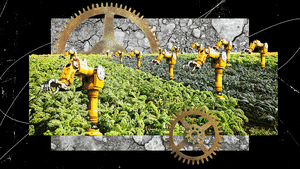When it comes to food, humanity’s looking down the barrel of a gun. The world’s population will balloon to almost 9.8 billion by 2050, leading to an expected 60-percent increase in demand for food. And the devastating effects of climate change aren’t doing any favors for our farming.
But there may be a silver lining—and it involves backpedaling evolution.
Researchers at Cornell University have found a way to resurrect an ancient form of an enzyme called rubisco, or RuBisCo, that promoted photosynthesis in plants millions of years ago, when Earth was experiencing one of its hottest climates in the last 50 million years. In a study published April 15 in the journal Science Advances, the researchers were able to use modern-day versions of rubisco to piece together an idea of what the enzyme looked like in ancient times. As a result, scientists may be able to harness its power once again to help ensure our crops of the future can adapt and resist climate change and provide us with all the fresh fruits, vegetables, and grains we need.
Although plants suck in carbon dioxide and produce oxygen, they aren’t exactly able to just make use of carbon dioxide in its current, gaseous form. Rubisco, short for ribulose-1,5-bisphosphate carboxylase/oxygenase and the most abundant enzyme found on Earth, transforms carbon dioxide into a biologically friendly form, which plants use to build their tissues.
One problem with rubisco is that it also interacts with oxygen. This undesirable mingling produces toxic byproducts that slow down photosynthesis and, by extension, impact crop yield. Scientists have been sussing out ways to mitigate this issue and improve crop production by genetically engineering plants to make an algae-derived form of the enzyme or other tweaks. But these efforts haven’t really borne fruit yet.
To solve this conundrum, the Cornell researchers took a trip down memory lane—25 to 50 million years ago when Earth was much hotter thanks to high amounts of atmospheric carbon dioxide (a whopping 500 to 800 parts per million, compared to the 413 ppm estimated in 2020). This meant modern-day rubisco likely had an ancestral version that was adapted to working under such extreme carbon dioxide levels.
The Cornell team recreated a phylogeny, a tree-like diagram that traces the evolutionary relationships between its members and shows how they evolved from a common ancestor. They did this by analyzing rubisco genes in plants of the Solanaceae (nightshade) family, which include potato, pepper, tomato, eggplant, and tobacco. And from this family tree, the researchers were able to create and gauge the biological activity of nearly a hundred of these potential ancient rubiscos in the lab using the bacteria E. coli.

Maureen Hanson and Myat Lin work in their lab in the Biotechnology Building at Cornell University.
Courtesy Cornell University“By getting a lot of [genetic] sequences of rubisco in existing plants, a phylogenetic tree could be constructed to figure out which rubiscos likely existed 20 to 30 million years ago,” Maureen Hanson, a molecular biologist at Cornell and the new study’s senior author, said in a press release. “We were able to identify predicted ancestral enzymes that do have superior qualities compared to current-day enzymes.”
The next big step for the research team will be to transfer the reconstructed versions of the rubisco genes into plants from the Solanaceae family like tomatoes and potentially others like rice or soybean and see whether photosynthesis activity improves and props up crop yield.
“For the next step, we want to replace the genes for the existing rubisco enzyme in tobacco with these ancestral sequences using CRISPR [gene-editing] technology, and then measure how it affects the production of biomass,” Hanson said. “We certainly hope that our experiments will show that by adapting rubisco to present-day conditions, we will have plants that will give greater yields.”
To a stressed planet with many hungry mouths to feed, that sounds like a good start.







